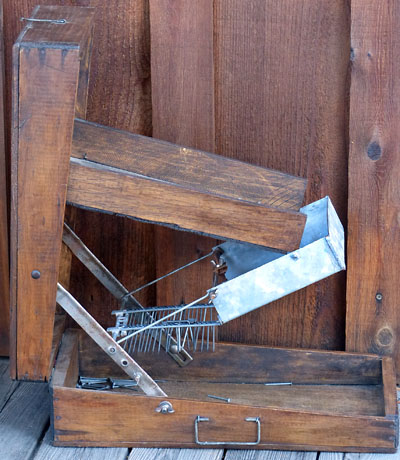home | internet service | web design | business directory | bulletin board | advertise | events calendar | contact | weather | cams

|
Inventor's Daughter < Back to Parker Nail-stripper story Esther Spurgeon was part of the Parker family. Her interview is from the book ‘The Whole Damn Valley’ by Diana Hottell, and is reprinted here with permission of the Shafer Museum. For Esther Spurgeon and her family, 1924 spelled B-A-D. Her father, Frank Parker, a fiercely individualistic and inventive man, had brought his wife and children to Boulder Creek, an unpopulated neck of the woods, even by Methow Valley standards. He felt he needed to get away so he could vent his creativity in solitude and run his machinery with water power. “Father was a hard guy to like,” Esther admitted. She claims he was so domineering that the first 21 years of her life were totally tied up with him and his projects. “He was his own doctor and thought he could carpenter better than anybody else, and he pretty near could. You could hardly find a chink in his armor,” she conceded.  The Parker Nail-stripper, invented by Esther Spurgeon's father and built by her and others in her family in their shop on Boulder Creek. The Parker Nail-stripper, invented by Esther Spurgeon's father and built by her and others in her family in their shop on Boulder Creek.With Henry Ford and the assembly line as Frank’s ideals, he put his entire family to work in his shop constructing his recently patented invention, the “Parker Nail-stripper,” which became the family’s main, and sometimes sole, source of income for years. They also built wooden toys. Little cradles and tables and chair sets for children, which they would bundle up and bring down to Wenatchee, where they would peddle them door-to-door. Nineteen twenty-four began well enough. Spring came and a garden was planted. But just when the vegetables were all well started and promised a winter without hunger, a generation of ground hogs moved in and devoured the lot. Their cow, strolling the ditch bank one day, fell into the water and drowned. The best thing about that bit of bad luck was the Frank allowed his family to eat the cow even though he had up to that point kept them all quite strictly vegetarian. That fall when the toys were made, they crated and loaded them onto the lumber wagon for the trek to Wenatchee. Esther’s eight-year-old brother Frankie was sick that night. In the morning, three feet of untimely snow blanketed the world. They all grabbed shovels and began to clear some of it away from the wagon and to shovel paths to the barn and the shop. Suddenly, Frankie grabbed his head in pain, called out, and fell dead. Charles, 14, and Glenn, 10, saddled two horses and rode three miles to the nearest phone to call the undertaker. The depleted, grieving family eventually made their trip to the city; they HAD to go since they now had a funeral bill to pay. When they were just about ready to return home they received a call from the valley informing them their house had burned to the ground and everything was lost. With the money they had made in Wenatchee they rented a garage in Winthrop and lived in it for a year. “Everyone felt so sorry for us they had a dance for our benefit and gave us great big boxes of clothes,” Esther said. “I washed and pressed them and cut them up and made them into new things. I was pretty bad at first, but I got better.” She certainly preferred sewing to working in her father’s workshop. She had never had much material before but all of a sudden the community was supplying her with all the yardage she could use. Dick McLean gave them a barrel of pickles and someone else gave them a side of beef. That winter Esther almost died of measles, but she came through realizing she wasn’t afraid of death. “And I’m still not,” she stated. 12/20/2012 Comments
|